Jennifer Bohnhoff's Blog, page 31
December 30, 2019
Quilts and History
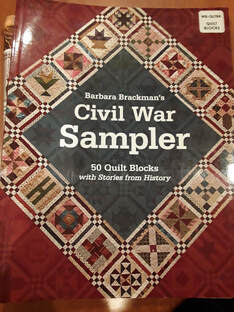 One of the presents I got this Christmas was a book entitled Civil War Sampler: 50 Quilt Blocks with Stories from History. The author, Barbara Brackman, is an historian and a quilter who has written many books on the history of quilts and the the history that can be found within vintage quilts. She even has an etsy site that offers vintage fabrics that would be perfect for recreating vintage quilts.
One of the presents I got this Christmas was a book entitled Civil War Sampler: 50 Quilt Blocks with Stories from History. The author, Barbara Brackman, is an historian and a quilter who has written many books on the history of quilts and the the history that can be found within vintage quilts. She even has an etsy site that offers vintage fabrics that would be perfect for recreating vintage quilts.In her introduction, Brackman explains that few of the blocks in this book actually date from the Civil War period. Most were published in the 1930s in the Chicago Tribune and Kansas City Star. Brackman used the symbolism in the names to recall events and people from the war. She bolsters her recollections with pictures and quotes from primary sources.
For instance, when introducing the quilt block known as Hovering Hawks, she explains that the word hawk, originally the name of a predatory bird, was used in the Civil War to describe any thief. This usage might have started with the Jayhawks, who raided towns in Kansas before the war began. Brackman includes two diary entries to support her argument.
 The book is primarily formatted in two page spreads that include pictures of a quilt block on the left. This is the page for a quilt block known as calico puzzle. Most left hand pages show two or three different coloration for the same block.
The book is primarily formatted in two page spreads that include pictures of a quilt block on the left. This is the page for a quilt block known as calico puzzle. Most left hand pages show two or three different coloration for the same block.The right hand page of each spread shares the Civil War connections, plus cutting and piecing instructions and references. This page talks about Clara Solomon, a New Orleans teenager whose diary talks about how the scarcity of fabric in the South affected her.
The book has chapters on four patch, nine patch, miscellaneous pieced blocks, piecing challenges and applique blocks, plus a section of templates. The book is beautifully laid out and filled with interesting trivia. I would recommend this book to quilters and people interested in the American Civil War.
 Jennifer Bohnhoff is a middle school language arts teacher and writer who lives in rural New Mexico. She has made a number of quilts for her home and her children and will soon finish one for her eldest grandaughter, which she promises to post to this blog soon.
Jennifer Bohnhoff is a middle school language arts teacher and writer who lives in rural New Mexico. She has made a number of quilts for her home and her children and will soon finish one for her eldest grandaughter, which she promises to post to this blog soon.Jennifer is currently working on Glorieta, the second in the series of historical novels set in New Mexico during the Civil War. For more information on her and her books, click here.
To see more on Barbara Brackman's books, click here. To read her blog, click here. For her etsy site, click here.
Published on December 30, 2019 04:33
October 6, 2019
If it's October, it must be Pumpkin
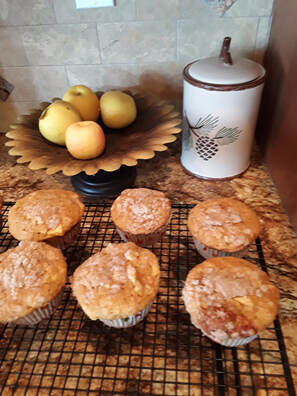 It's October: high season for anything pumpkin.
It's October: high season for anything pumpkin.I know a lot of pumpkin haters who groan about how pumpkin pervades the market every fall. Consider, though, that the American native is a nutritional heavyweight. This variation of squash originated in Mexico and is very high in dietary Fiber, vitamins A and C, riboflavin, potassium, copper, and manganese. Pumpkin is also a good source of vitamin E, thiamin, niacin, vitamin B6, folate, iron, magnesium, and phosphorus.
I think God made pumpkin a fall fruit so that our bodies would be ready to fight the cold of winter.
 peeled, cored and chopped, apples give these muffins an extra sweet punch I love pumpkin so much that my boys grew up eating a lot of pumpkiny food in the fall. My youngest son's favorite pie was pumpkin. We ate a lot of rich pumpkin bread slathered in cream cheese. Pumpkin donuts were a definite every fall. And yes, we ate pumpkin muffins. Interested in any of the above? Let me know and I'll share a recipe with you.
peeled, cored and chopped, apples give these muffins an extra sweet punch I love pumpkin so much that my boys grew up eating a lot of pumpkiny food in the fall. My youngest son's favorite pie was pumpkin. We ate a lot of rich pumpkin bread slathered in cream cheese. Pumpkin donuts were a definite every fall. And yes, we ate pumpkin muffins. Interested in any of the above? Let me know and I'll share a recipe with you.Here's a recipe for muffins that have pumpkin and diced apple in them, and are crowned with a crunchy streusel topping that would make any muffin special. Try it on blueberry muffins or just plain muffins to make them not-so-plain afterall.
I'm including a second pumpkin muffin recipe in my upcoming Manic Muffin Mix Cookbook, which I'll be giving to all the members of my Friends, Fan and Family elist in December. Want in? Sign up to receive my emails here. Pumpkin Apple Streusel Muffins
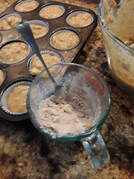 This topping would make any muffin special
This topping would make any muffin special For streusel topping, mix in a small bowl
1/4 cup sugar
2 TBS flour
1/2 tsp cinnamon
Use a fork to blend in, mixing until crumbly:
1 1/2 TBS Butter
Set aside streusel topping.
For muffins, mix thoroughly in a large bowl
2 eggs
1 1/2 tsp. vanilla
1/2 cup salad oil
1 cup water
1 cup solid pack pumpkin
1/2 TBS pumpkin pie spice
Add
1 cup peeled and finely chopped apples
Add and stir in until no dry areas remain
2 3/4 cup muffin mix
Spoon batter into greased or paper-lined muffin cups, filling 3/4 full.
Sprinkle streusel topping over batter
Bake in a preheated 350° oven 30-35 minutes, until a toothpick inserted into one comes out clean.
 Jennifer Bohnhoff' lives in the mountains in central New Mexico, where she teaches middle school language arts. Since her three sons have grown up and moved away, she only makes muffins and other foods for her husband and visiting friends. She is the author of historical novels set in several different time periods and a series of funny contemporary novels for middle readers. She is currently working on an historical novel set in New Mexico during the Civil War. You can read more about her books on her website by clicking here.
Jennifer Bohnhoff' lives in the mountains in central New Mexico, where she teaches middle school language arts. Since her three sons have grown up and moved away, she only makes muffins and other foods for her husband and visiting friends. She is the author of historical novels set in several different time periods and a series of funny contemporary novels for middle readers. She is currently working on an historical novel set in New Mexico during the Civil War. You can read more about her books on her website by clicking here.
Published on October 06, 2019 12:43
September 29, 2019
Alexander Grzelachowski: a Famous New Mexican
 Last spring I gave a lecture at the Bear Canyon Senior Center on Civil War battles in New Mexico. Afterwards, one woman in the audience raised her hand and told me that her great-great grandfather had been a chaplain for the Union Army at the Battle of Glorieta. When I asked her if she was Polish, she smiled, knowing that I knew who she was talking about.
Last spring I gave a lecture at the Bear Canyon Senior Center on Civil War battles in New Mexico. Afterwards, one woman in the audience raised her hand and told me that her great-great grandfather had been a chaplain for the Union Army at the Battle of Glorieta. When I asked her if she was Polish, she smiled, knowing that I knew who she was talking about.Alexander Grzelachowski was born in 1824 in Gracina, Poland. The son of a Polish Officer in the Napoleonic Wars, he became a Catholic priest, then emigrated to the United States in 1847. He served in Ohio until 1851, when he accompanied Jean Baptiste Lamy, the principle figure in Willa Cather’s novel Death Comes to the Archbishop, to New Mexico. He served several parishes, including Manzano’s Our Lady of Sorrows. Grzelachowski spoke fluent Spanish, and his parishioners called him Padre Polaco, the Polish Father.
 Grzelachowski left the priesthood in 1857 to open a mercantile business in Las Vegas, but when the Civil War broke out, he felt compelled to reenter the priesthood in order to serve his adopted country. He became the 2nd New Mexico Volunteers’ chaplain, and played a critical role in the Battle of Glorieta Pass.
Grzelachowski left the priesthood in 1857 to open a mercantile business in Las Vegas, but when the Civil War broke out, he felt compelled to reenter the priesthood in order to serve his adopted country. He became the 2nd New Mexico Volunteers’ chaplain, and played a critical role in the Battle of Glorieta Pass.Late on the night of March 28, 1862, Major John Chivington and his men became lost in a snowstorm in the treacherous and uncharted terrain atop Glorieta Mesa. Chivington had set out that morning with orders to drop down on the Confederate rear, so that his 400 men and Colonel John Slough’s 800 men could trap Colonel Scurry’s 1,300 Confederate troops between them. Instead, Chivington and his men had strayed off course, gone too far, and found themselves staring down at Johnson’s Ranch, where the Confederates had left their supply train under a light guard. Chivington had destroyed that train, an act that forced the Confederates to retreat to Texas, securing New Mexico for the Union.
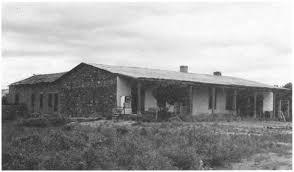 Grzelachowski's store in Puerto de Luna By nightfall, Chivington’s men were struggling back over Glorieta Mesa. What little intelligence they received suggested that Slough’s inferior numbers had failed to hold the field. The men atop the mesa had no idea where they could descend without encountering enemy troops. The night was dark and stormy, and snow fell heavily. Suddenly, an apparition appeared out of the gloom. It was an imposingly large man on a horse so white that it appeared to glow. Many soldiers thought an angel had appeared in their midst. That angel turned out to be Alexander Grzelachowski, who led the men safely around the Confederate troops and reunited them with Colonel Slough’s men. It was not an easy job. In fact, it was so difficult that Grzelachowski’s horse collapsed and died as he led the men into camp. But without the Father, it might have been Chivington’s troops who died by blundering into an enemy camp or succumbing to the elements.
Grzelachowski's store in Puerto de Luna By nightfall, Chivington’s men were struggling back over Glorieta Mesa. What little intelligence they received suggested that Slough’s inferior numbers had failed to hold the field. The men atop the mesa had no idea where they could descend without encountering enemy troops. The night was dark and stormy, and snow fell heavily. Suddenly, an apparition appeared out of the gloom. It was an imposingly large man on a horse so white that it appeared to glow. Many soldiers thought an angel had appeared in their midst. That angel turned out to be Alexander Grzelachowski, who led the men safely around the Confederate troops and reunited them with Colonel Slough’s men. It was not an easy job. In fact, it was so difficult that Grzelachowski’s horse collapsed and died as he led the men into camp. But without the Father, it might have been Chivington’s troops who died by blundering into an enemy camp or succumbing to the elements.After the war, Grzelachowski returned to private life. He started a family in 1870, marrying Secundina C. de Baca, with whom he fathered at least two daughters, Emma and Adelina. By 1872, the family had moved to Puerto de Luna, a little town on the bank of the Pecos River, about nine miles south of Santa Rosa. Here he opened a mercantile store similar to the one he operated in Las Vegas. He also ran a ranch, raised sheep, cattle and horses, and maintained a large orchard and vineyard.
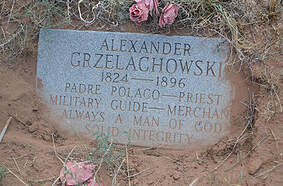 Alexander Grzelachowski’s life intersected with many of New Mexico’s most famous and infamous citizens. Even though William Bonney, the young outlaw commonly known as Billy the Kid, reputedly rustled horses from one of his ranches, Grzelachowski seemed to have liked the young outlaw. He instructed his store clerks to allow Billy to take whatever supplies he needed. Bonney attended dances hosted by Grzelachowski, and on December 25, 1880, when Lincoln county Sheriff Pat Garrett and his posse was taking Bonney to jail in Las Vegas, the whole group stopped in Puerto de Luna, where Grzelachowski served Billy wild turkey and all the fixings for his last Christmas dinner.
Alexander Grzelachowski’s life intersected with many of New Mexico’s most famous and infamous citizens. Even though William Bonney, the young outlaw commonly known as Billy the Kid, reputedly rustled horses from one of his ranches, Grzelachowski seemed to have liked the young outlaw. He instructed his store clerks to allow Billy to take whatever supplies he needed. Bonney attended dances hosted by Grzelachowski, and on December 25, 1880, when Lincoln county Sheriff Pat Garrett and his posse was taking Bonney to jail in Las Vegas, the whole group stopped in Puerto de Luna, where Grzelachowski served Billy wild turkey and all the fixings for his last Christmas dinner.Grzelachowski continued to be active in civil affairs throughout his life. He was the postmaster for Puerto de Luna, operating the post office out of his mercantile store. He also used the store as his chambers while he served as San Miguel county’s justice of the peace. After he helped lobby the territorial legislature for the creation of Guadalupe county from the southern part of San Miguel county in 1893, he served as the new county's first probate judge. Three new commissioners for Guadalupe county were sworn into office in his store.
In 1896, when he was 72 years old, the man often called Don Alejandro was thrown from a wagon while riding to his Alamogordo ranch. He is buried in the Nuestra Senora De Los Dolores Cemetery outside of Milagro, a small town in Guadalupe county.
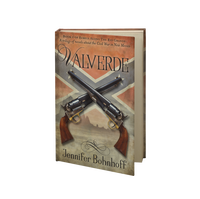 Jennifer Bohnhoff is a native New Mexican who has learned about many interesting New Mexicans while researching her two Civil War novels, Valverde (published in 2017) and Glorieta (to be published in 2020.)
Jennifer Bohnhoff is a native New Mexican who has learned about many interesting New Mexicans while researching her two Civil War novels, Valverde (published in 2017) and Glorieta (to be published in 2020.) She wishes to thank Bernadette Flores for sharing pictures and stories of her illustrious ancestor, who will have a small role in her upcoming book.
Published on September 29, 2019 19:20
September 15, 2019
Running with the Little Dogs
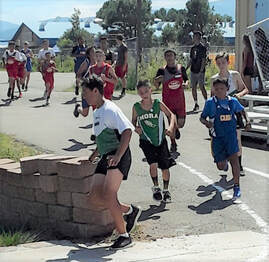 Middle School boys running at a recent meet in Penasco, New Mexico. One of the author's runners, in blue, is in the far left.
Middle School boys running at a recent meet in Penasco, New Mexico. One of the author's runners, in blue, is in the far left. This fall, after a two year hiatus, I have returned to coaching a middle school cross country team. It is an interesting job, to say the least. Middle schoolers, who are in 6th-8th grade, come in all sizes and shapes, and have varying temperaments, from upbeat, silly and optimistic to gothic and depressed. Some middle schoolers run that emotional gamut in a single day. They are raging bundles of adolescent hormones and angst, teetering on the brink of adulthood, then falling backwards into toddler tantrums when they least expect it. If anyone needs the physical release of a good, long run, it's a middle schooler.
My first experience with middle school cross country was in 2007. That was the fall when I returned to teaching after a 22 year stint as a stay-at-home mom. The only job I could find was as a substitute, and I thought that volunteering to help with afterschool activities would help my job prospects. I didn't know that I would find the experience so satisfying that I would continue to coach long after I'd secured a full time teaching position.
When I first began coaching, I was a competent runner who participated in road races of 5K to marathon length, and I could run in the middle of the middle school pack. By the end of that first season, however, I was running in the back. My middle schoolers improved in the course of the season, and I didn't. Each season after that I began a little farther back in the pack and finished a little slower. Students who I'd encouraged to "finish strong" were now doing the same for me.
I'm now in my third year teaching in a rural school east of Albuquerque, and for the first time, I've rejoined the team. I am slower than ever, which qualifies me to run sweep. I run at the back, helping those who have side stitches, have had encounters with cacti, or just forgot to eat anything but Doritos for lunch and have nothing left to fuel their bodies. Some students only run with me once before they find their mojo and return to the middle and front of the pack. Others run in the back with me every day. They are the little dogs, and the whiners and wheezers.
While the whiners run in the back with me every day, their excuses seem to be new each run. They can be highly entertaining. A couple of weeks ago, one runner couldn't run, he said, because he had a mosquito bite. I asked him where it was. He searched both arms, his legs, and then the back of his neck before admitting that he couldn't remember. Another day, he claimed he had a lung cramp. On a hot afternoon, he asked me to tell his mother than he loved her if he didn't live to see the end of the two mile course.
He is not my only frequent companion. One girl stops to pick wildflowers. Another stops to gawk every time a hawk appears in the sky. Some days I do more walking - and nagging - than running.
 Jennifer Bohnhoff teaches and coaches at a middle school in rural New Mexico. Her most recent book, Super Hec, is about a middle school boy who trains to run a 5K. You can read more about all of her books here.
Jennifer Bohnhoff teaches and coaches at a middle school in rural New Mexico. Her most recent book, Super Hec, is about a middle school boy who trains to run a 5K. You can read more about all of her books here.
Published on September 15, 2019 09:27
September 9, 2019
Super Shirt
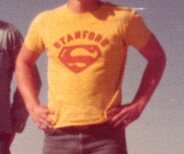 Ever wonder where authors get their ideas? Sometimes they percolate for a very long time before they find a place in a story. A good example is this super shirt.
Ever wonder where authors get their ideas? Sometimes they percolate for a very long time before they find a place in a story. A good example is this super shirt.My latest book, Super Hec, came out this week. It is the third book in the Anderson Chronicles, and it tell the story of what happens to geeky middle schooler Hector Anderson when he decides to take up running. The faded, old t shirt that figures throughout the story has a story of its own.
 Super shirt first shows up at the very beginning of the story, when Eddie, Hec's best friend, pulls it out of his backpack. The forever disorganized Hec has realized that he's forgotten the t shirt he uses for P.E., and his grade will suffer if he can't dress out. Fortunately for Hec, Eddie carries this old t shirt as a spare, saving Hec's grade but making him the butt of jokes in the locker room.
Super shirt first shows up at the very beginning of the story, when Eddie, Hec's best friend, pulls it out of his backpack. The forever disorganized Hec has realized that he's forgotten the t shirt he uses for P.E., and his grade will suffer if he can't dress out. Fortunately for Hec, Eddie carries this old t shirt as a spare, saving Hec's grade but making him the butt of jokes in the locker room.When Sandy, the girl of Hec's dreams, comments on the shirt, it becomes a talisman for him. He is convinced his "lucky" shirt is helping him train for a 5K road race. Eddie's father, the original owner of the shirt, shares training tips with Hec as he remembers his glory days on the Stanford track team. As Hec's legs strengthen and his runs become easier, he can't bear to be parted from Super shirt. It becomes so stinky that his mother begs him to let her wash it. Super shirt made its first appearance in my life when I was a young bride back in 1980. My husband and I were moving across country, and I was packing the content of a desk drawer when I came upon an unexposed roll of film. I took it to the store to have it developed. When I returned a week later to pick the pictures up, I flipped through the snapshots, then told the man behind the counter that he had made a mistake. I didn't recognize any of the people in the pictures, nor any of the Italianate, stucco buildings. Clearly, he had given me someone else's pictures.
The man smiled. He explained that the faded colors indicated that the film had been exposed a long time ago, and had lingered, undeveloped, in the can for a long time, perhaps years. He suggested I take them home and show them to my husband. Perhaps he would recognize the people and places that I didn't. After an argument, I agreed to take the pictures home, but I was sure I would return the next day, vindicated by my husband's inability to recognize those people and places. I was wrong. The pictures, it turned out, were five years old. The Italianate building were on the Stanford University campus, where my husband had attended, and the pictures were of him and his classmates. I had never been to Stanford. I had never met most of the people in the pictures. But the humiliating part was that I hadn't even recognized my own husband, even in the picture in which he was wearing a shirt I had seen many times.
 In that picture, my husband is standing triumphantly at the top of Mount Whitney, California's highest peak. He was a young man at the top of his game and on top of the world. His horizon seemed limitless, the future unclouded. By the time I married him, the t shirt was faded and had some holes, but he still loved it and the memories it brought back to him.
In that picture, my husband is standing triumphantly at the top of Mount Whitney, California's highest peak. He was a young man at the top of his game and on top of the world. His horizon seemed limitless, the future unclouded. By the time I married him, the t shirt was faded and had some holes, but he still loved it and the memories it brought back to him. A lot has changed in the nearly 40 years since I developed that picture, but I am happy to say that my husband and I both aged better than the t shirt.
Jennifer Bohnhoff is an author who still runs with middle school students at the school where she teaches English and coaches the cross country team. Her latest book, Super Hec , is available in both paperback and ebook from Amazon.
Published on September 09, 2019 00:00
September 2, 2019
Apple Muffins for Back to School
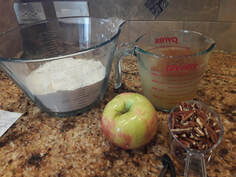 September is here, and with it come thoughts of fall, back to school, and apples.
September is here, and with it come thoughts of fall, back to school, and apples. Really, none of the things that I associate with the time right after Labor Day are really timely. At least for me, school began in the first half of August! Fall doesn't really begin on Labor Day, but on September 21st. And apples come into season somewhere between the middle of July and late November depending on the variety and the climate.
Still, I think September is a good time to mix up a batch of apple muffins. Heck, any time of year is good for these muffins! Because these start with a muffin mix that you can keep in your pantry, these come together so quickly that you can make them up even if you have to be out the door and running the car pool. The cinnamon gives the air a warm, comforting smell, and substituting applesauce for oil makes these extra healthy. So give them a try and see if they don't make it to the head of your muffin class. Apple Muffins Preheat the oven to 350 degrees. Line cupcake tins with paper liners.
2 eggs
1 cup water
1/2 cup applesauce
2 3/4 cup Manic Muffin Mix
1/4 tsp. cinnamon
1/2 cup chopped pecans
1 honeycrisp apple
 Peel, core, and dice the apple into pieces about the size of a raisin. You should have about 1 cup. I selected honeycrisp because they're my husband's favorite, but any crisp apple will do. Gala, granny smith and Braeburn are also good apples for baking because they hold their shape. Mix all the ingredients together until there is no dry mix left.
Peel, core, and dice the apple into pieces about the size of a raisin. You should have about 1 cup. I selected honeycrisp because they're my husband's favorite, but any crisp apple will do. Gala, granny smith and Braeburn are also good apples for baking because they hold their shape. Mix all the ingredients together until there is no dry mix left. 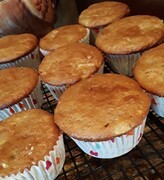 Fill tins 3/4 full. Bake for 20 minutes, or until the muffins have brown tops and a toothpick stuck into the center of one comes out dry.
Fill tins 3/4 full. Bake for 20 minutes, or until the muffins have brown tops and a toothpick stuck into the center of one comes out dry.Make about 18 muffins. These muffins freeze well. Take them out of the freezer the night before and leave them on the counter, and they will be ready to eat in the morning.
Published on September 02, 2019 00:00
August 19, 2019
Cake Mix Cookies, Part Two
This summer I tried making cookies from a boxed cake mix. They turned out so well that I decided to make another variation. They, too, were excellent! Give them a try. You'll find they're really easy and very tasty. Chocolate, White Chocolate and Macadamia Nut Cookies 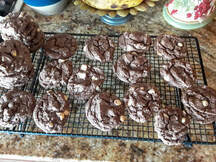 1 box chocolate cake mix
1 box chocolate cake mix
2 eggs
1/2 cup vegetable oil
1/2 cup white chocolate chips
1/2 cup chopped macadamia nuts
Mix all together until there is no dry powdery mix left. Form into balls a little smaller than a golf ball and place 2 inches apart on an ungreased baking sheet. Bake until set around the edges, about 10-12 minutes. Let cool before removing from the baking sheet.
Makes about 2 dozen.
 1 box chocolate cake mix
1 box chocolate cake mix2 eggs
1/2 cup vegetable oil
1/2 cup white chocolate chips
1/2 cup chopped macadamia nuts
Mix all together until there is no dry powdery mix left. Form into balls a little smaller than a golf ball and place 2 inches apart on an ungreased baking sheet. Bake until set around the edges, about 10-12 minutes. Let cool before removing from the baking sheet.
Makes about 2 dozen.
Published on August 19, 2019 00:00
August 5, 2019
Zucchini Muffins
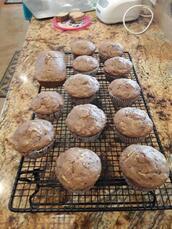 August. High summer. If you have a garden, chances are you have more zucchini than you know what to do with. You can get rid of a little by using Manic Monday Muffin Mix to make zucchini muffins.
August. High summer. If you have a garden, chances are you have more zucchini than you know what to do with. You can get rid of a little by using Manic Monday Muffin Mix to make zucchini muffins.My granddaughter spends more time up at my mountain house during the summer. On a recent visit she helped me make zucchini muffins. She's six, but she loves to bake and she did a pretty good job of measuring and mixing the ingredients and getting them into the muffin tin.
Zucchini Muffins
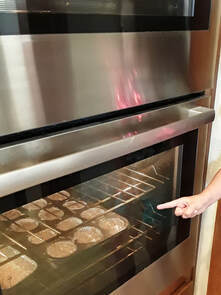 Preheat oven to 350. Line muffin tins with paper cups
Preheat oven to 350. Line muffin tins with paper cups2 3/4 cup 2 eggs
1 1/2 tsp vanilla
1 cup water
1/2 cup oil
1 cup grated zucchini
1 TBS cinnamon
1/2 cup chopped walnuts
Mix all ingredients until no dry mix remains. Spoon into muffin cups and bake 20 minutes, or until lightly browned.
 Jennifer Bohnhoff is an author and educator who lives in the mountains outside Albuquerque, New Mexico. She is currently at work on a book set in New Mexico during the Civil War and another set in New Mexico and France during World War I.
Jennifer Bohnhoff is an author and educator who lives in the mountains outside Albuquerque, New Mexico. She is currently at work on a book set in New Mexico during the Civil War and another set in New Mexico and France during World War I.She's been working on a variation of Manic Muffins every month this year, and plans to produce a little cookbook with all the recipes this fall. If you'd like more information, you can join her friends and family email list.
Published on August 05, 2019 00:00
July 29, 2019
The Raid on Columbus
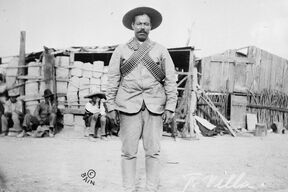 Pancho Villa Many people consider 9/11/2001 the day that America lost its feeling of security. But al-Qaeda’s suicide attacks of the four hijacked that crashed into the World Trade Center in New York City, the Pentagon just outside Washington, D.C., and a field in Pennsylvania was not the first time enemies had attacked on American soil. The United States suffered invasions during the War of 1812, the Mexican American War, and in 1916, when Pancho Villa raided the New Mexican town of Columbus.
Pancho Villa Many people consider 9/11/2001 the day that America lost its feeling of security. But al-Qaeda’s suicide attacks of the four hijacked that crashed into the World Trade Center in New York City, the Pentagon just outside Washington, D.C., and a field in Pennsylvania was not the first time enemies had attacked on American soil. The United States suffered invasions during the War of 1812, the Mexican American War, and in 1916, when Pancho Villa raided the New Mexican town of Columbus.
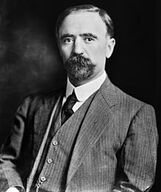 Francisco I. Madero In 1910, Mexico became embroiled in a revolution that was intent on radically transforming its culture and government. It began when the 31-year-long regime of Porfirio Díaz rigged an election against a challenging wealthy landowner named Francisco I. Madero. This led to an armed rebellion that put Madero into power. Madero’s presidency couldn’t unite the people. Conservatives saw him as weak and liberal. Former revolutionary fighters and the dispossessed saw him as too conservative. Madero resigned in February 1913, and was later assassinated.
Francisco I. Madero In 1910, Mexico became embroiled in a revolution that was intent on radically transforming its culture and government. It began when the 31-year-long regime of Porfirio Díaz rigged an election against a challenging wealthy landowner named Francisco I. Madero. This led to an armed rebellion that put Madero into power. Madero’s presidency couldn’t unite the people. Conservatives saw him as weak and liberal. Former revolutionary fighters and the dispossessed saw him as too conservative. Madero resigned in February 1913, and was later assassinated.
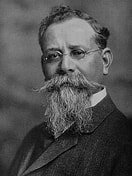 Venustiano Carranza Backed by business interests and other supporters of the old order, General Victoriano Huerta’s counter-revolutionary regime came to power. In July 1914 a coalition of regional revolutionary forced him out and one of their leaders, Venustiano Carranza, took control with the support of American President Woodrow Wilson.
Venustiano Carranza Backed by business interests and other supporters of the old order, General Victoriano Huerta’s counter-revolutionary regime came to power. In July 1914 a coalition of regional revolutionary forced him out and one of their leaders, Venustiano Carranza, took control with the support of American President Woodrow Wilson.
Not all of the revolutionaries supported Carranza. One of the leaders in opposition was Pancho Villa, the commander of the northern division of the army centered in Chihuahua. Villa had received a lot of support from Americans in the past and was shocked when this support dried up. Lacking military supplies, money, and munitions, Villa’s army degenerated into a disorganized mob that wandered around northern Mexico, foraging, raping, and looting as they went. On March 9, 1916, his troops crossed the border ant attacked the tiny town of Columbus, New Mexico. At the time of the attack, New Mexico had only been a state for four years, but that doesn't mean it was a "new" place. Native Americans had lived in it for thousands of years. In 1598 Spain colonized it, but lost it when Mexico gained its independence in 1824. In 1848, at the conclusion of the Mexican-American War, the United States annexed New Mexico as a territory. It was finally admitted to the Union as the 47th state on January 6, 1912. It continues to be the state with the highest percentage of Hispanic and Latino Americans, and still has close ties with Mexico.
Historians still argue about why Villa crossed the border. One theory is that he wanted to punish the United States for withdrawing its support for his cause. Another is that merchants in Columbus had cheated him in an arms deal. Finally, Villa might have been desperate for the arms and horses he though he could get from the raid.
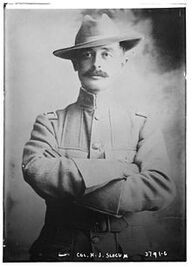 The day before the attack, a ranch foreman named Juan Favela rode to Camp Columbus, a small post established to patrol the border. Favela warned Colonel Herbert Jermain Slocum, the commander of the 13th Cavalry, that Villa and his forces were in Palomas, a bordertown only three miles south of Columbus. Slocum reinforced the troops at the Border Gate and stepped up patrols along the 65-mile border, but he wasn’t overly concerned. Although not all men were in garrison, the 13th Cavalry Regiment had a headquarters troop, a machine gun troop, and four of the seven rifle troops deployed to patrol the border: 12 officers and 341 men in all. Villa, he was sure, wouldn’t dare attack a force that large. Captured Villistas later revealed that the spies Villa sent into Columbus returned with reports that only thirty or so soldiers were garrisoned at the Camp, however, and this misinformation may have convinced Villa of Columbus’ vulnerability.
The day before the attack, a ranch foreman named Juan Favela rode to Camp Columbus, a small post established to patrol the border. Favela warned Colonel Herbert Jermain Slocum, the commander of the 13th Cavalry, that Villa and his forces were in Palomas, a bordertown only three miles south of Columbus. Slocum reinforced the troops at the Border Gate and stepped up patrols along the 65-mile border, but he wasn’t overly concerned. Although not all men were in garrison, the 13th Cavalry Regiment had a headquarters troop, a machine gun troop, and four of the seven rifle troops deployed to patrol the border: 12 officers and 341 men in all. Villa, he was sure, wouldn’t dare attack a force that large. Captured Villistas later revealed that the spies Villa sent into Columbus returned with reports that only thirty or so soldiers were garrisoned at the Camp, however, and this misinformation may have convinced Villa of Columbus’ vulnerability.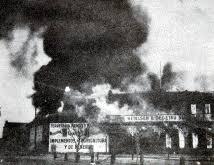 Columbus burning during the raid Villa crossed the border about midnight. He took up a position on Cootes Hill overlooking Columbus, and at 4:15 am on the morning of March 9 launched a two-pronged attack on the town from the west and southeast. Most of his 380 man army left their horses with Villa and moved in on foot.
Columbus burning during the raid Villa crossed the border about midnight. He took up a position on Cootes Hill overlooking Columbus, and at 4:15 am on the morning of March 9 launched a two-pronged attack on the town from the west and southeast. Most of his 380 man army left their horses with Villa and moved in on foot.Columbus was a small town, with only a few adobe houses, a couple of hotels, a grocery store, a drug store, a few mercantile businesses and a railway station lining its sandy streets. People in both the town and garrison awoke in the dark to shouts of "Viva Villa!” and “Viva Mexico!" Villa’s army looted the stores and set them on fire. If their proprietors got in the way, they were shot. J.J. Moore, who owned a mercantile shop, was. So was C.C. Miller, the town’s druggist. The fire spread to the Commercial Hotel, where the Villistas robbed people as they fled the burning buildings. Four civilians were killed there, six elsewhere.
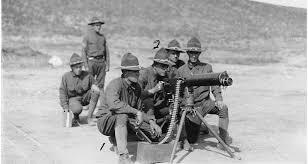 But Columbus didn’t go down without a fight. Many of the townspeople defended themselves with rifles and shotguns. 2nd Lt. John Lucas heard the noise and, so hastily that he never got into his boots, made his way from his private quarters to the camp's guard tent, where he broke into the lockers that kept his troop's machine guns secure. Lucas set up four emplacements of men, each with a Hotchkiss M1909 Benét-Mercié machine gun. He was soon joined by 30 troopers armed with Springfield rifles.
But Columbus didn’t go down without a fight. Many of the townspeople defended themselves with rifles and shotguns. 2nd Lt. John Lucas heard the noise and, so hastily that he never got into his boots, made his way from his private quarters to the camp's guard tent, where he broke into the lockers that kept his troop's machine guns secure. Lucas set up four emplacements of men, each with a Hotchkiss M1909 Benét-Mercié machine gun. He was soon joined by 30 troopers armed with Springfield rifles.
At first the night was so dark that the soldiers couldn’t see their enemies. The only way to locate Villistas were the muzzle flashes as they fired. As the Commercial’s blaze grew, it backlit the Villistas, making them easy targets. Close to 20,000 rounds were fired from the machine guns during the 90-minute fight.
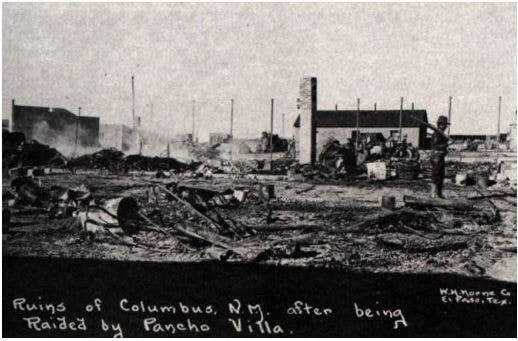 As the sky lightened, Villa's bugler called a retreat. Villa left behind his dead and wounded and slipped back into Mexico. The dead Villistas and their horses were dragged to a pit, doused with kerosene and set on fire. The lives ones were jailed. All but one were later hanged. Columbus went through a period of intense mourning. The tiny town that no one had heard of was suddenly on the front page of every paper in America. Its notoriety didn’t last long, however. America’s entrance into World War I made a Mexican’s raid on a small border town in a little known state pale into obscurity. Americans wouldn’t feel that vulnerable again until Pearl Harbor.
As the sky lightened, Villa's bugler called a retreat. Villa left behind his dead and wounded and slipped back into Mexico. The dead Villistas and their horses were dragged to a pit, doused with kerosene and set on fire. The lives ones were jailed. All but one were later hanged. Columbus went through a period of intense mourning. The tiny town that no one had heard of was suddenly on the front page of every paper in America. Its notoriety didn’t last long, however. America’s entrance into World War I made a Mexican’s raid on a small border town in a little known state pale into obscurity. Americans wouldn’t feel that vulnerable again until Pearl Harbor.Jennifer Bohnhoff teaches school in rural central New Mexico. She has written a number of historical fiction novels and is currently at work on one set in Southern New Mexico during the time of the Villa raid.
Published on July 29, 2019 00:00
July 22, 2019
Living off the Iron Harvest
This summer, my husband and I had the extreme pleasure of touring World War I battlefields in Belgium and Northern France. We have always gone on trips like this on our own. We’ve done the research, made the reservations, and done all the planning by ourselves. For this trip, I felt I overwhelmed by the number of places I wanted to go. I was afraid I’d miss something crucial. So we booked a tour with a company called Beyond Band of Brothers. It turned out to be an excellent decision.
 One of the things that BBoB does that really enhances the experience is hire local tour guides. In Flanders, a region that now encompasses part of Belgium and France, that was Iain McHenry, a published author and historian whose understanding of battle tactics and cemeteries was encyclopedic. Iain began studying the Great War when he was in the military and assigned to Belgium. He has since gone on to do research for families of soldiers, for BBC programs, and for his book on the 177th Tunneling Company.
One of the things that BBoB does that really enhances the experience is hire local tour guides. In Flanders, a region that now encompasses part of Belgium and France, that was Iain McHenry, a published author and historian whose understanding of battle tactics and cemeteries was encyclopedic. Iain began studying the Great War when he was in the military and assigned to Belgium. He has since gone on to do research for families of soldiers, for BBC programs, and for his book on the 177th Tunneling Company.
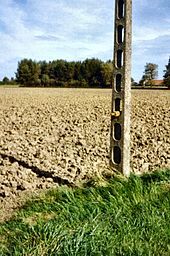 A telegraph pole on the side of a field in Belgium. Note the shells that a farmer has placed in it for disposal. While we were driving from one site to another, Iain explained that a lot of unexploded ordnance still litters the fields of Flanders. Much of it is still dangerous. France's Department of Mine Clearance, for instance, recovers 900 tons of UXO every year.
A telegraph pole on the side of a field in Belgium. Note the shells that a farmer has placed in it for disposal. While we were driving from one site to another, Iain explained that a lot of unexploded ordnance still litters the fields of Flanders. Much of it is still dangerous. France's Department of Mine Clearance, for instance, recovers 900 tons of UXO every year.
Farmers in the region have taken to calling this the Iron Harvest. Every year, especially during the spring planting and fall ploughing, they uncover unexploded ordnance, rolls of barbed wire, shrapnel, bullets, and other things in their fields. Iain explained that a lot of farmers carry what they find to the sides of their fields and deposit them where bomb squads can recover them. Iain took us to one farm, whose inhabitants have not only endured the dangers of living and farming such dangerous soil, but embraced its history. As we pulled into the farmyard of Pond Farm, a pleasant, middle-aged blond woman welcomed us.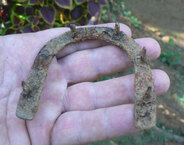 She explained in halting English that the farm had been completely destroyed during World War I. When her great-grandfather returned after the war, he built a small shed for the family to live in. Next came a barn, and then the house in which the family lives today. Eventually, shed became a museum of things they picked up in the fields.
She explained in halting English that the farm had been completely destroyed during World War I. When her great-grandfather returned after the war, he built a small shed for the family to live in. Next came a barn, and then the house in which the family lives today. Eventually, shed became a museum of things they picked up in the fields.
The collection was intriguing. One thing I noticed were dozens of tiny horseshoes. Noting the confusion on my face, she explained that they were not actually for ponies; they were the heel guards from the hobnailed boots that both German and English soldiers wore.
Her son, Stijn, became intrigued by all the ephemera of war. He's been collecting things from the fields since he was a child. When he found the remnants of a tank in his field, he decided to build one of his own. He requested plans for a Mark IV from the British government and has been working on building one ever since. His mother was pleased to show us his handiwork, parked in the barn among the farm equipment. Building a tank is no small or inexpensive feat. If you would like to help, donations would be gratefully accepted here.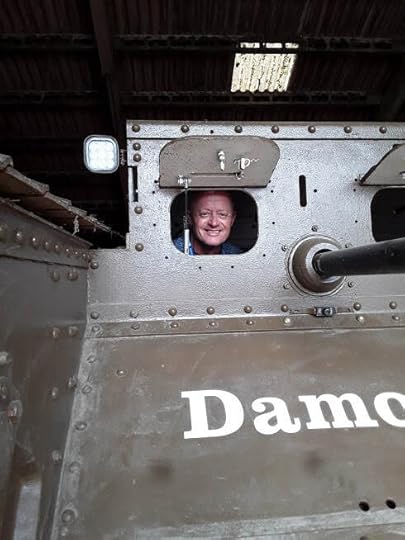
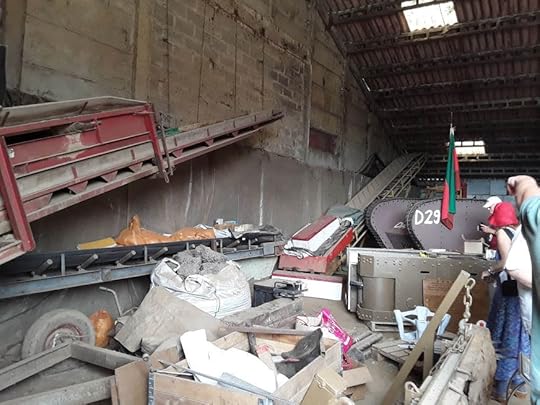

 World War I has been over now for a hundred years, but the land and its people are still recovering. The Iron Harvest is a legacy that will continue to challenge the people for centuries to come.
World War I has been over now for a hundred years, but the land and its people are still recovering. The Iron Harvest is a legacy that will continue to challenge the people for centuries to come.
 One of the things that BBoB does that really enhances the experience is hire local tour guides. In Flanders, a region that now encompasses part of Belgium and France, that was Iain McHenry, a published author and historian whose understanding of battle tactics and cemeteries was encyclopedic. Iain began studying the Great War when he was in the military and assigned to Belgium. He has since gone on to do research for families of soldiers, for BBC programs, and for his book on the 177th Tunneling Company.
One of the things that BBoB does that really enhances the experience is hire local tour guides. In Flanders, a region that now encompasses part of Belgium and France, that was Iain McHenry, a published author and historian whose understanding of battle tactics and cemeteries was encyclopedic. Iain began studying the Great War when he was in the military and assigned to Belgium. He has since gone on to do research for families of soldiers, for BBC programs, and for his book on the 177th Tunneling Company.
 A telegraph pole on the side of a field in Belgium. Note the shells that a farmer has placed in it for disposal. While we were driving from one site to another, Iain explained that a lot of unexploded ordnance still litters the fields of Flanders. Much of it is still dangerous. France's Department of Mine Clearance, for instance, recovers 900 tons of UXO every year.
A telegraph pole on the side of a field in Belgium. Note the shells that a farmer has placed in it for disposal. While we were driving from one site to another, Iain explained that a lot of unexploded ordnance still litters the fields of Flanders. Much of it is still dangerous. France's Department of Mine Clearance, for instance, recovers 900 tons of UXO every year. Farmers in the region have taken to calling this the Iron Harvest. Every year, especially during the spring planting and fall ploughing, they uncover unexploded ordnance, rolls of barbed wire, shrapnel, bullets, and other things in their fields. Iain explained that a lot of farmers carry what they find to the sides of their fields and deposit them where bomb squads can recover them. Iain took us to one farm, whose inhabitants have not only endured the dangers of living and farming such dangerous soil, but embraced its history. As we pulled into the farmyard of Pond Farm, a pleasant, middle-aged blond woman welcomed us.
 She explained in halting English that the farm had been completely destroyed during World War I. When her great-grandfather returned after the war, he built a small shed for the family to live in. Next came a barn, and then the house in which the family lives today. Eventually, shed became a museum of things they picked up in the fields.
She explained in halting English that the farm had been completely destroyed during World War I. When her great-grandfather returned after the war, he built a small shed for the family to live in. Next came a barn, and then the house in which the family lives today. Eventually, shed became a museum of things they picked up in the fields. The collection was intriguing. One thing I noticed were dozens of tiny horseshoes. Noting the confusion on my face, she explained that they were not actually for ponies; they were the heel guards from the hobnailed boots that both German and English soldiers wore.
Her son, Stijn, became intrigued by all the ephemera of war. He's been collecting things from the fields since he was a child. When he found the remnants of a tank in his field, he decided to build one of his own. He requested plans for a Mark IV from the British government and has been working on building one ever since. His mother was pleased to show us his handiwork, parked in the barn among the farm equipment. Building a tank is no small or inexpensive feat. If you would like to help, donations would be gratefully accepted here.



 World War I has been over now for a hundred years, but the land and its people are still recovering. The Iron Harvest is a legacy that will continue to challenge the people for centuries to come.
World War I has been over now for a hundred years, but the land and its people are still recovering. The Iron Harvest is a legacy that will continue to challenge the people for centuries to come.
Published on July 22, 2019 00:00



